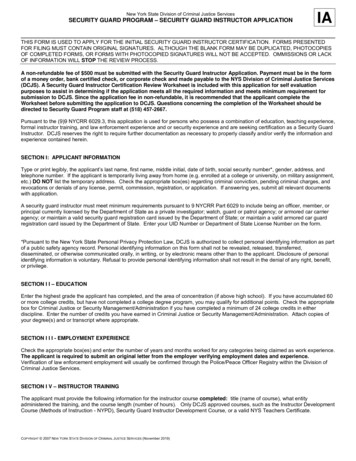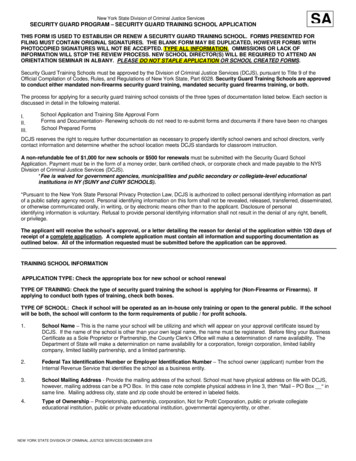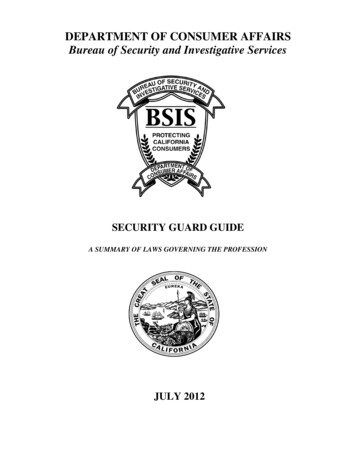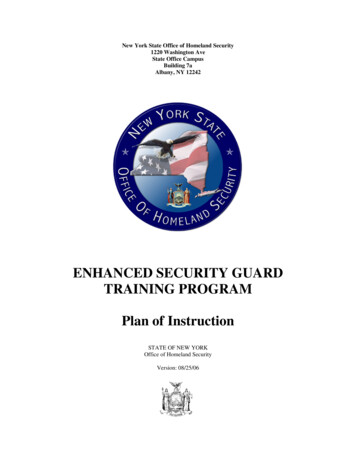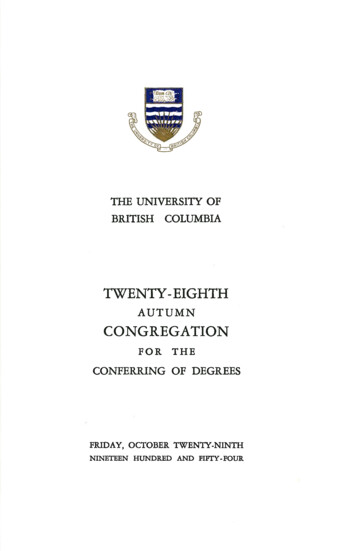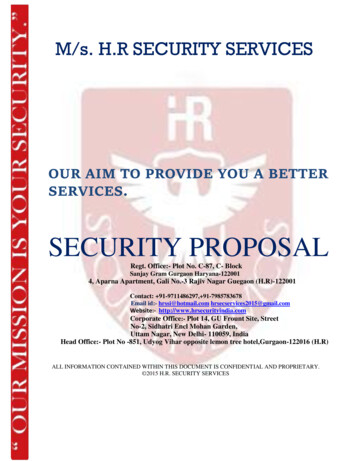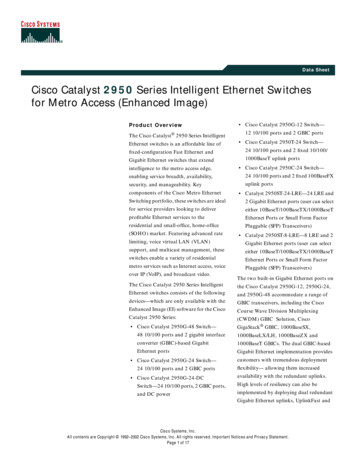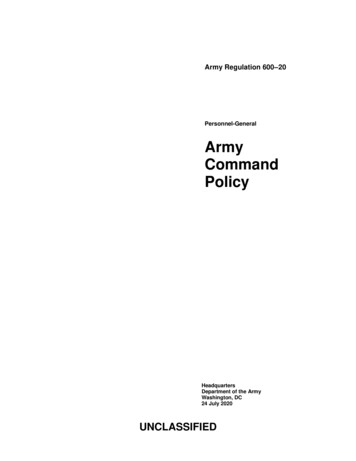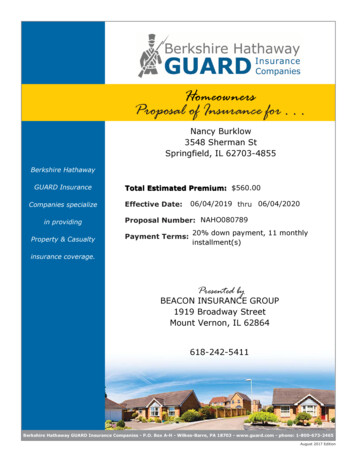
Transcription
Federal Protective ServiceSecurity Guard Information ManualSecure Facilities, Safe OccupantsFor Official Use Only
Inside Front CoverLeft Blank Intentionally
ContentsChapter 1: The Department of Homeland Security and the Federal Protective Service . . . . . . . . . . . . . . . . . . . . 11.1: Overview of the Department of Homeland Security (DHS) . . . . . . . . . . . . . . . . . . . . . . . . . . . . . . . . . .1.2: Overview of Immigration and Customs Enforcement (ICE) . . . . . . . . . . . . . . . . . . . . . . . . . . . . . . . . .1.3: Overview of the Federal Protective Service (FPS) . . . . . . . . . . . . . . . . . . . . . . . . . . . . . . . . . . . . . . . . . .1.4: Five Types of Facilities and Security Levels . . . . . . . . . . . . . . . . . . . . . . . . . . . . . . . . . . . . . . . . . . . . . . .1113. 52.1: Your Roles and Responsibilities . . . . . . . . . . . . . . . . . . . . . . . . . . . . . . . . . . . . . . . . . . . . . . . . . . . . . . . . 52.2: Typical Duties . . . . . . . . . . . . . . . . . . . . . . . . . . . . . . . . . . . . . . . . . . . . . . . . . . . . . . . . . . . . . . . . . . . . . 62.3: Creating a Good Image . . . . . . . . . . . . . . . . . . . . . . . . . . . . . . . . . . . . . . . . . . . . . . . . . . . . . . . . . . . . . . 82.4: Basic Appearance Standards . . . . . . . . . . . . . . . . . . . . . . . . . . . . . . . . . . . . . . . . . . . . . . . . . . . . . . . . . . . 92.5: Acceptable and Unacceptable Conduct . . . . . . . . . . . . . . . . . . . . . . . . . . . . . . . . . . . . . . . . . . . . . . . . . . . 112.6: Interacting with People . . . . . . . . . . . . . . . . . . . . . . . . . . . . . . . . . . . . . . . . . . . . . . . . . . . . . . . . . . . . . . 132.7: Sexual Harassment . . . . . . . . . . . . . . . . . . . . . . . . . . . . . . . . . . . . . . . . . . . . . . . . . . . . . . . . . . . . . . . . . . 152.8: Traits of a Top-Notch Security Guard . . . . . . . . . . . . . . . . . . . . . . . . . . . . . . . . . . . . . . . . . . . . . . . . . . . . 16Chapter 2: The Security GuardChapter 3: Federal Laws and Regulations, Crimes and Procedures . . . . . . . . . . . . . . . . . . . . . . . . . . . . . . . . . . 193.1: Understanding Federal Laws and Regulations . . . . . . . . . . . . . . . . . . . . . . . . . . . . . . . . . . . . . . . . . . . . . 193.2: Common Offenses . . . . . . . . . . . . . . . . . . . . . . . . . . . . . . . . . . . . . . . . . . . . . . . . . . . . . . . . . . . . . . . . . . 203.3: Reporting Incidents to the FPS MegaCenter . . . . . . . . . . . . . . . . . . . . . . . . . . . . . . . . . . . . . . . . . . . . . . . 233.4: Jurisdiction . . . . . . . . . . . . . . . . . . . . . . . . . . . . . . . . . . . . . . . . . . . . . . . . . . . . . . . . . . . . . . . . . . . . . . . 243.5: Search and Seizure . . . . . . . . . . . . . . . . . . . . . . . . . . . . . . . . . . . . . . . . . . . . . . . . . . . . . . . . . . . . . . . . . . 253.6: Detainment Authority . . . . . . . . . . . . . . . . . . . . . . . . . . . . . . . . . . . . . . . . . . . . . . . . . . . . . . . . . . . . . . . 253.7: The Use of Force . . . . . . . . . . . . . . . . . . . . . . . . . . . . . . . . . . . . . . . . . . . . . . . . . . . . . . . . . . . . . . . . . . . 263.8: Crime Scene Protection and Evidence Procedures . . . . . . . . . . . . . . . . . . . . . . . . . . . . . . . . . . . . . . . . . . 263.9: Testimony . . . . . . . . . . . . . . . . . . . . . . . . . . . . . . . . . . . . . . . . . . . . . . . . . . . . . . . . . . . . . . . . . . . . . . . . 27Chapter 4: Security Guard Contract Administration . . . . . . . . . . . . . . . . . . . . . . . . . . . . . . . . . . . . . . . . . . . . . . 294.1:Your Job as a Security Guard . . . . . . . . . . . . . . . . . . . . . . . . . . . . . . . . . . . . . . . . . . . . . . . . . . . . . . . . . . 294.2: Relationship Between the Contractor and the Government . . . . . . . . . . . . . . . . . . . . . . . . . . . . . . . . . . . 294.3: The Post Duty Book . . . . . . . . . . . . . . . . . . . . . . . . . . . . . . . . . . . . . . . . . . . . . . . . . . . . . . . . . . . . . . . . . 304.4: Work Schedules . . . . . . . . . . . . . . . . . . . . . . . . . . . . . . . . . . . . . . . . . . . . . . . . . . . . . . . . . . . . . . . . . . . . 304.5: Weapons and Equipment . . . . . . . . . . . . . . . . . . . . . . . . . . . . . . . . . . . . . . . . . . . . . . . . . . . . . . . . . . . . . 304.6: Posts . . . . . . . . . . . . . . . . . . . . . . . . . . . . . . . . . . . . . . . . . . . . . . . . . . . . . . . . . . . . . . . . . . . . . . . . . . . . 334.7: General Response Procedures . . . . . . . . . . . . . . . . . . . . . . . . . . . . . . . . . . . . . . . . . . . . . . . . . . . . . . . . . . 344.8: Emergency Plans . . . . . . . . . . . . . . . . . . . . . . . . . . . . . . . . . . . . . . . . . . . . . . . . . . . . . . . . . . . . . . . . . . . 34Chapter 5: Controlling Access and Egress . . . . . . . . . . . . . . . . . . . . . . . . . . . . . . . . . . . . . . . . . . . . . . . . . . . . . . 375.1: Why Control Access and Egress . . . . . . . . . . . . . . . . . . . . . . . . . . . . . . . . . . . . . . . . . . . . . . . . . . . . . . . . 375.2: Personnel Control . . . . . . . . . . . . . . . . . . . . . . . . . . . . . . . . . . . . . . . . . . . . . . . . . . . . . . . . . . . . . . . . . . 375.3: Property Control . . . . . . . . . . . . . . . . . . . . . . . . . . . . . . . . . . . . . . . . . . . . . . . . . . . . . . . . . . . . . . . . . . . 385.4: Vehicle Control . . . . . . . . . . . . . . . . . . . . . . . . . . . . . . . . . . . . . . . . . . . . . . . . . . . . . . . . . . . . . . . . . . . . 395.5: Lock and Key Control . . . . . . . . . . . . . . . . . . . . . . . . . . . . . . . . . . . . . . . . . . . . . . . . . . . . . . . . . . . . . . . 39Federal Protective Service Security Guard Information Manual, 2008 RevisionFor Official Use Onlyi
Chapter 6: Intrusion Detection, Assessment and Response . . . . . . . . . . . . . . . . . . . . . . . . . . . . . . . . . . . . . . . . 416.1: Means of Detecting Intrusions . . . . . . . . . . . . . . . . . . . . . . . . . . . . . . . . . . . . . . . . . . . . . . . . . . . . . . . . . 416.2: Assessing Possible Intrusions . . . . . . . . . . . . . . . . . . . . . . . . . . . . . . . . . . . . . . . . . . . . . . . . . . . . . . . . . . 426.3: Intrusion Response Procedures . . . . . . . . . . . . . . . . . . . . . . . . . . . . . . . . . . . . . . . . . . . . . . . . . . . . . . . . 42Chapter 7: Facility Safety Procedures and Response . . . . . . . . . . . . . . . . . . . . . . . . . . . . . . . . . . . . . . . . . . . . . 457.1: The Basics of Facility Safety . . . . . . . . . . . . . . . . . . . . . . . . . . . . . . . . . . . . . . . . . . . . . . . . . . . . . . . . . . . 457.2: Fire Alarm Systems . . . . . . . . . . . . . . . . . . . . . . . . . . . . . . . . . . . . . . . . . . . . . . . . . . . . . . . . . . . . . . . . . 457.3: Response Procedures . . . . . . . . . . . . . . . . . . . . . . . . . . . . . . . . . . . . . . . . . . . . . . . . . . . . . . . . . . . . . . . 467.4: Knowledge and Use of Fire Extinguishers . . . . . . . . . . . . . . . . . . . . . . . . . . . . . . . . . . . . . . . . . . . . . . . 467.5: Acts of God or Other Serious Situations . . . . . . . . . . . . . . . . . . . . . . . . . . . . . . . . . . . . . . . . . . . . . . . . . 46Chapter 8: Records and Reports . . . . . . . . . . . . . . . . . . . . . . . . . . . . . . . . . . . . . . . . . . . . . . . . . . . . . . . . . . . . 478.1: Signing In and Out . . . . . . . . . . . . . . . . . . . . . . . . . . . . . . . . . . . . . . . . . . . . . . . . . . . . . . . . . . . . . . . . . 478.2: General Guidelines for Report Writing . . . . . . . . . . . . . . . . . . . . . . . . . . . . . . . . . . . . . . . . . . . . . . . . . . 488.3: Collecting Information for Reports . . . . . . . . . . . . . . . . . . . . . . . . . . . . . . . . . . . . . . . . . . . . . . . . . . . . . 488.4: Taking Notes . . . . . . . . . . . . . . . . . . . . . . . . . . . . . . . . . . . . . . . . . . . . . . . . . . . . . . . . . . . . . . . . . . . . . . 498.5: Report Writing . . . . . . . . . . . . . . . . . . . . . . . . . . . . . . . . . . . . . . . . . . . . . . . . . . . . . . . . . . . . . . . . . . . . 508.6: Filing Reports . . . . . . . . . . . . . . . . . . . . . . . . . . . . . . . . . . . . . . . . . . . . . . . . . . . . . . . . . . . . . . . . . . . . . 50Chapter 9: Special Situations . . . . . . . . . . . . . . . . . . . . . . . . . . . . . . . . . . . . . . . . . . . . . . . . . . . . . . . . . . . . . . . 519.1: Escort Duties . . . . . . . . . . . . . . . . . . . . . . . . . . . . . . . . . . . . . . . . . . . . . . . . . . . . . . . . . . . . . . . . . . . . . . 519.2: Dealing with Seriously Disruptive Behavior . . . . . . . . . . . . . . . . . . . . . . . . . . . . . . . . . . . . . . . . . . . . . . . 519.3: Code Adam . . . . . . . . . . . . . . . . . . . . . . . . . . . . . . . . . . . . . . . . . . . . . . . . . . . . . . . . . . . . . . . . . . . . . . . 52Chapter 10: Emergency First Aid . . . . . . . . . . . . . . . . . . . . . . . . . . . . . . . . . . . . . . . . . . . . . . . . . . . . . . . . . . . . 5310.1: First Aid/CPR/AED . . . . . . . . . . . . . . . . . . . . . . . . . . . . . . . . . . . . . . . . . . . . . . . . . . . . . . . . . . . . . . . . 5310.2: Blood Borne Pathogens . . . . . . . . . . . . . . . . . . . . . . . . . . . . . . . . . . . . . . . . . . . . . . . . . . . . . . . . . . . . . 53Chapter 11: Combating Terrorism . . . . . . . . . . . . . . . . . . . . . . . . . . . . . . . . . . . . . . . . . . . . . . . . . . . . . . . . . . . 5511.1: What is Terrorism and Who Are Terrorists . . . . . . . . . . . . . . . . . . . . . . . . . . . . . . . . . . . . . . . . . . . . . . . 5511.2: Types of Terrorists Attacks . . . . . . . . . . . . . . . . . . . . . . . . . . . . . . . . . . . . . . . . . . . . . . . . . . . . . . . . . . . 5611.3: Weapons of Mass Destruction (WMD) . . . . . . . . . . . . . . . . . . . . . . . . . . . . . . . . . . . . . . . . . . . . . . . . . 5611.4: Preventing Terrorist Attacks . . . . . . . . . . . . . . . . . . . . . . . . . . . . . . . . . . . . . . . . . . . . . . . . . . . . . . . . . . 5611.5: Responding to a Terrorist Attack . . . . . . . . . . . . . . . . . . . . . . . . . . . . . . . . . . . . . . . . . . . . . . . . . . . . . . 57Chapter 12: Workplace Violence . . . . . . . . . . . . . . . . . . . . . . . . . . . . . . . . . . . . . . . . . . . . . . . . . . . . . . . . . . . . 5912.1: What is Workplace Violence . . . . . . . . . . . . . . . . . . . . . . . . . . . . . . . . . . . . . . . . . . . . . . . . . . . . . . . . . . 5912.2: Who Commits Violent Acts and Why . . . . . . . . . . . . . . . . . . . . . . . . . . . . . . . . . . . . . . . . . . . . . . . . . . . 5912.3: Preventing Workplace Violence . . . . . . . . . . . . . . . . . . . . . . . . . . . . . . . . . . . . . . . . . . . . . . . . . . . . . . . . 6012.4: Responding to Incidents of Workplace Violence . . . . . . . . . . . . . . . . . . . . . . . . . . . . . . . . . . . . . . . . . . . 60Chapter 13: Civil Disturbances . . . . . . . . . . . . . . . . . . . . . . . . . . . . . . . . . . . . . . . . . . . . . . . . . . . . . . . . . . . . . . 6113.1: Types of Civil Disturbances . . . . . . . . . . . . . . . . . . . . . . . . . . . . . . . . . . . . . . . . . . . . . . . . . . . . . . . . . . 6113.2: Impact of Civil Disturbances . . . . . . . . . . . . . . . . . . . . . . . . . . . . . . . . . . . . . . . . . . . . . . . . . . . . . . . . . 6113.3: Demonstrations . . . . . . . . . . . . . . . . . . . . . . . . . . . . . . . . . . . . . . . . . . . . . . . . . . . . . . . . . . . . . . . . . . . 6213.4: Response Procedures . . . . . . . . . . . . . . . . . . . . . . . . . . . . . . . . . . . . . . . . . . . . . . . . . . . . . . . . . . . . . . . 62iiFor Official Use OnlySecurity Guard Information Manual, 2008 Revision Federal Protective Service
Chapter 14 Bomb/Weapons of Mass Destruction, Threats and Incidents . . . . . . . . . . . . . . . . . . . . . . . . . . . . . . 6314.1: Receiving Bomb/WMD Threats . . . . . . . . . . . . . . . . . . . . . . . . . . . . . . . . . . . . . . . . . . . . . . . . . . . . . . . 6314.2: Reporting Bomb/WMD Threats . . . . . . . . . . . . . . . . . . . . . . . . . . . . . . . . . . . . . . . . . . . . . . . . . . . . . . . 6414.3: Locating and Handling Suspicious Items . . . . . . . . . . . . . . . . . . . . . . . . . . . . . . . . . . . . . . . . . . . . . . . . 6414.4: Response Procedures . . . . . . . . . . . . . . . . . . . . . . . . . . . . . . . . . . . . . . . . . . . . . . . . . . . . . . . . . . . . . . . 65Chapter 15 Hostage Situations . . . . . . . . . . . . . . . . . . . . . . . . . . . . . . . . . . . . . . . . . . . . . . . . . . . . . . . . . . . . . 6715.1: What is a Hostage Situation . . . . . . . . . . . . . . . . . . . . . . . . . . . . . . . . . . . . . . . . . . . . . . . . . . . . . . . . . . 6715.2: Reacting to Hostage Situations . . . . . . . . . . . . . . . . . . . . . . . . . . . . . . . . . . . . . . . . . . . . . . . . . . . . . . . . 67Chapter 16 Sabotage and Espionage . . . . . . . . . . . . . . . . . . . . . . . . . . . . . . . . . . . . . . . . . . . . . . . . . . . . . . . . . 6916.1: What are Sabotage and Espionage? . . . . . . . . . . . . . . . . . . . . . . . . . . . . . . . . . . . . . . . . . . . . . . . . . . . . . 6916.2: Deterrence, Prevention, and Response to Incidents . . . . . . . . . . . . . . . . . . . . . . . . . . . . . . . . . . . . . . . . 69Chapter 17 Child Care Centers . . . . . . . . . . . . . . . . . . . . . . . . . . . . . . . . . . . . . . . . . . . . . . . . . . . . . . . . . . . . . . 7117.1: Child Care Centers in Federal Buildings . . . . . . . . . . . . . . . . . . . . . . . . . . . . . . . . . . . . . . . . . . . . . . . . . 7117.2:Your Responsibilities . . . . . . . . . . . . . . . . . . . . . . . . . . . . . . . . . . . . . . . . . . . . . . . . . . . . . . . . . . . . . . . 71Appendix 1: Regulations Affecting Federal Property . . . . . . . . . . . . . . . . . . . . . . . . . . . . . . . . . . . . . . . . . . . . . . 73Title 41—Public Contracts and Property Management;Chapter 102—Federal Management Regulation;Part 102-74 Facility Management; Subpart C—Conduct on Federal Property . . . . . . . . . . . . . . . . . . . . . . . . 73U.S. Code, Title 18—Crimes And Criminal Procedure;Part I—Crimes;Chapter 44—Firearms . . . . . . . . . . . . . . . . . . . . . . . . . . . . . . . . . . . . . . . . . . . . . . . . . . . . . . . . . . . . . . . . . 76Appendix 2: Sample Forms and Reports . . . . . . . . . . . . . . . . . . . . . . . . . . . . . . . . . . . . . . . . . . . . . . . . . . . . . . 77Bomb Threat Questionnaire . . . . . . . . . . . . . . . . . . . . . . . . . . . . . . . . . . . . . . . . . . . . . . . . . . . . . . . . . . . . . . 77Questions derived from FBI Bomb Data Program Card . . . . . . . . . . . . . . . . . . . . . . . . . . . . . . . . . . . . . . . . . . 79Appendix 3: Practice Written Examination and Answer Key . . . . . . . . . . . . . . . . . . . . . . . . . . . . . . . . . . . . . . . . 81Information, Guidelines and Helpful Hints for Taking the Written Examination . . . . . . . . . . . . . . . . . . . . . . . 81Practice Examination . . . . . . . . . . . . . . . . . . . . . . . . . . . . . . . . . . . . . . . . . . . . . . . . . . . . . . . . . . . . . . . . . . . . 82Appendix 4: FLETC Use of Force Model (Form SH-8704, Rev. 04/99) . . . . . . . . . . . . . . . . . . . . . . . . . . . . . . . . . 85Introduction . . . . . . . . . . . . . . . . . . . . . . . . . . . . . . . . . . . . . . . . . . . . . . . . . . . . . . . . . . . . . . . . . . . . . . . . . . 85Use of Force Model . . . . . . . . . . . . . . . . . . . . . . . . . . . . . . . . . . . . . . . . . . . . . . . . . . . . . . . . . . . . . . . . . . . . 85Officer Perception . . . . . . . . . . . . . . . . . . . . . . . . . . . . . . . . . . . . . . . . . . . . . . . . . . . . . . . . . . . . . . . . . . . . . . 85Subject Action . . . . . . . . . . . . . . . . . . . . . . . . . . . . . . . . . . . . . . . . . . . . . . . . . . . . . . . . . . . . . . . . . . . . . . . . . 86Officer Response . . . . . . . . . . . . . . . . . . . . . . . . . . . . . . . . . . . . . . . . . . . . . . . . . . . . . . . . . . . . . . . . . . . . . . . 87Color Correlation . . . . . . . . . . . . . . . . . . . . . . . . . . . . . . . . . . . . . . . . . . . . . . . . . . . . . . . . . . . . . . . . . . . . . . 87Tools, Tactics and Timing . . . . . . . . . . . . . . . . . . . . . . . . . . . . . . . . . . . . . . . . . . . . . . . . . . . . . . . . . . . . . . . . . 88Federal Protective Service Security Guard Information Manual, 2008 RevisionFor Official Use Onlyiii
Page ivLeft Blank Intentionally
Chapter 1The Department of Homeland Securityand the Federal Protective ServiceThis section provides an overview of the mission ofDHS, ICE and FPS. It will also describe the differenttypes of work places that you may be protecting. Inorder for you to appreciate the importance of yourjob, you need to understand the mission of DHS,the role that FPS plays and the different environments in which you may be working.1.1: Overview of the Department ofHomeland SecurityThe National Strategy for Homeland Security and theHomeland Security Act of 2002 served to mobilizeand organize our nation to secure the homeland fromterrorist attacks. This exceedingly complex missionrequires a focused effort from our entire society if weare to be successful. To this end, one primary reasonfor the establishment of DHS was to provide the unifying core for the vast national network of organizations and institutions involved in efforts to secure ournation. In order to better do this and to provide guidance to the 180,000 DHS men and women whowork every day on this important task, the department developed its own high-level strategic plan. Thevision and mission statements, strategic goals andobjectives provide the framework guiding the actionsthat make up the daily operations of the department.VisionPreserving our freedoms, protecting America we secure our homeland.MissionWe will lead the unified national effort to secureAmerica. We will prevent and deter terrorist attacksand protect against as well as respond to threats andhazards to the nation.We will ensure safe and secure borders, welcomelawful immigrants and visitors and promote thefree-flow of commerce.1.2: Overview of the Immigration andCustoms EnforcementWith the establishment of DHS, the functions,expertise, resources and jurisdictions of severalonce-fragmented border and security agencies weremerged and reconstituted into ICE, DHS’s largestinvestigative bureau. The agencies that were eithermoved entirely or merged in part, based upon lawenforcement functions, included the investigativeand intelligence resources of the United States Customs Service, the Immigration and NaturalizationServiceand FPS.1.3: Overview of the Federal ProtectiveServiceFPS is responsible for delivering a comprehensivephysical security and law enforcement program inall GSA owned or leased facilities. This involves providing law enforcement and security for more thana million federal workers and visitors at over 8,300buildings nationwide. FPS enforces laws and regulations governing public buildings, maintains law andorder and protects life and property in federallycontrolled work places.At FPS, our goal is to become a premier facilitysecurity organization that provides a safe environment in which federal agencies can conduct theirbusiness. To accomplish this, we will reduce threatsposed against federal facilities. These threats rangefrom the most catastrophic, but least probableFederal Protective Service Security Guard Information Manual, 2008 RevisionFor Official Use Only1
Criminal Investigations(terrorist attacks), to the most probable but leastcatastrophic (larcenies), with work place violencefalling at the center of this continuum.FPS Special Agents (SA) are non-uniformed agentswho investigate crimes that occur on federally controlled property. Investigators interview suspects andwitnesses, conduct searches and seizures and collectand present evidence. These agents carry firearmsand enforce federal laws for the protection of people and property in federal facilities.FPS is committed to ensuring the appropriate levelof security is in place at each federally controlledfacility throughout the country, regardless of itslocation. FPS is ready to respond to our customers’security and law enforcement needs.FPS partners with other federal, state and local agencies throughout the nation to develop specific solutions to challenges; assists with police emergencyand special security services; and offers police andsecurity support to law enforcement departmentsduring high-profile and sensitive events. To makefederal facilities safer, FPS also consults with building owners and tenants to advise them on physicalsecurity measures. FPS provides crime preventioneducation for agencies and individuals, and recommends strategies to keep everyone safer, both onand off the job. Services fall into eight components:Administrative Support, Communications, CriminalInvestigations, Law Enforcement, Management,Physical Security, Security Guard Services and Security Systems. The organization is comprised of theheadquarters and eleven (11) regions.Administrative SupportFPS’s administrative support team performs all otherfunctions not described above, such as contracting,budgeting, quality assurance, suitability adjudications and clerical support.You may encounter someof these personnel, although most of your contactwill be with FPS law enforcement personnel.CommunicationsFour (4) FPS MegaCenters provide communicationsfor security and law enforcement activities on aninter-and intra-regional basis. The centers also act asinformation and control hubs during emergency situations. Open 24 hours a day, 7 days a week, theMegaCenters monitor alarms, receive customer calls,dispatch law enforcement and emergency personnel, and retrieve information from other government agencies. As a security guard, you will havefrequent contact with the FPS MegaCenter.2For Official Use OnlyLaw EnforcementThe FPS law enforcement personnel are the mostvisible component of FPS’s law enforcement operations. They respond to and investigate reports ofcrime, provide advice to client agencies on securityissues, work with client agencies to improve facilityand social conditions, and protect client agencyoperations and lawful assemblies from unwarranteddisruptions.ManagementFPS’s management, both at the headquarters and atthe regional level, is responsible for developing andproviding programs, policies, leadership, guidanceand oversight for FPS personnel.Physical SecurityFPS physical security specialists (PSS) and inspectorsconduct security assessments of federally controlledbuildings and advise client agencies and employeesabout pertinent physical security issues affectingthem. Security assessments identify the securityneeds of individual facilities and recommendthe most effective security measures to protectthe facilities. PSSs conduct recurring on-site inspections that objectively evaluate criteria such asthe environment, crime rate, physical structure,tenant mix and architectural features to create acomprehensive assessment.Additionally, PSSs usually recommend the positionand hours of operation of the guard posts in federally controlled facilities and develop post orders foreach post in coordination with tenant agencies andother key personnel. The implementation of securitycountermeasures, to include contract guards, areapproved and paid for by the tenant agencies.Security Guard Information Manual, 2008 Revision Federal Protective Service
Security Guard ServicesFPS relies on security guards such as you to protectfederally controlled property throughout the nation.You are the most visible security presence and thefirst public contact with security upon entering thefacility. Although you are not employed by the federal government, you have a crucial role in FPS’smission and operations. We value the support provided by you to assist the FPS security team.Your primary responsibilities are to control access tofederal property; to assist in ensuring the safety ofemployees and visitors while on federal property;and to assist in ensuring the safety of federal property. Access control includes checking visitor andemployee identification; operating security equipment such as x-ray machines and Magnetometers toscreen for prohibited materials; operating or monitoring security cameras and/or alarms; and reporting crimes and incidents to the FPS MegaCenter.FPS relies heavily on you to be the “eyes andears”while accomplishing your security mission.You should always be aware of your surroundingsand the people with whom you interact. If younotice something out of ordinary that is suspicious,you should document it and report it to the FPSMegaCenter and your supervisor in accordance withyour post orders. If a crime or serious incidentoccurs in your facility, you will be one of the firstpeople interviewed to see what information you cansupply to assist in the investigation.Security SystemsElectronic security system specialists design, install,maintain, repair and operate security systems forfederally controlled facilities. This group also develops cost estimates, prepares contract specificationsand monitors contractors’ performance on FPScontracts for security system installations. As asecurity guard, you may come into contact withthese individuals when they are installing or repairing security equipment at your post or in yourassigned facility.1.4: Five Types of Facilities andSecurity LevelsThe list below was developed by a federal interagency working group (including FPS), headed bythe U.S. Department of Justice. The facility typeswere published in the Department of Justice Vulnerability Assessment of Federal Buildings, dated June28, 1995.You should know the profile, characteristics and tenants of the facility you are assigned to.Level ITypically, the Level I facility houses 10 or fewer federal employees in a space not greater than 2,500square feet. There is a low volume of public contactor contact with a small segment of the population.A military recruiting office is an example of a smallLevel I “store front”type facility.Some characteristics of a Level I facility are: the federal organization is a single tenant in aleased office; the building has no set back from the surrounding streets; there are other offices or businesses in thebuilding; there is meter or public parking immediatelyadjacent to the building; the standard hours of operation are less than 12hours per day; it does not have perimeter lights; it may have a simple power back-up feature foremergency lighting and fire detection systems; the facility most likely has high-security locks onall exterior doors; the locks are probably the onlymeasure of security for this level facility; and security guards are not typically assigned to aFederal Protective Service Security Guard Information Manual, 2008 RevisionLevel I facility.For Official Use Only3
Level IILevel IVTypically, the Level II facility has between 11 and150 federal employees with a moderate volume ofpublic contact. The federal activities are routine innature, similar to commercial activities. The buildings are from 2,500 square feet to 80,000 squarefeet. A typical Level II building is a Social SecurityAdministration office.Typically, the Level IV facility has 451 or more federal employees housed in more than 150,000square feet. The facility usually has a high volume ofpublic contact. The tenant agencies may includehigh-risk law enforcement agencies, courts, judicialoffices and offices housing highly sensitive government records. For example, a typical Level IV building is the Department of Justice Headquartersbuilding in Washington, D.C.Some characteristics of a Level II facility are: the building most likely is a multi-storySome characteristics of a Level IV facility are:structure; it may be set back from the street; it will have some interior underground parking the building probably is older. There are manyhistorical buildings in this category;as well as exterior parking; except for a sidewalk, the building may have no the building is accessed by employees more thanset back from the surrounding streets;12 hours per day and may be open to employees24 hours per day; only exterior parking is available and it is adjacent to the building; and the building operates an average of 12 hours public access is limited to less than 12 hoursLevel IIILevel VTypically, the Level III facility has between 151 and450 federal employees. In addition, the facilityprobably has between 80,000 and 150,000 squarefeet of space and a moderate to high volume ofpublic contact. The tenant agencies may include lawenforcement agencies, court-related agencies andfunctions, and government records and archives. ThePension Building, a multi-tenant, historical buildingin Washington, D.C. is an example of a typical LevelIII building.The Pentagon and CIA Headquarters are examples ofLevel V facilities. Level V facilities contain missionfunctions critical to national security. The missionsof Level V facilities require that tenant agenciessecure the site according to their own requirements.The degree to which these requirements dictatesecurity features in excess of those for a Level IV isestablished by the individual agency. A Level V facility will be similar to a Level IV facility in terms ofnumber of employees and square fo
2 For Official Use Only Security Guard Information Manual, 2008 Revision Federal Protective Service. Security Guard Services FPS relies on security guards such as you to protect federally controlled property throughout the nation. You are th
